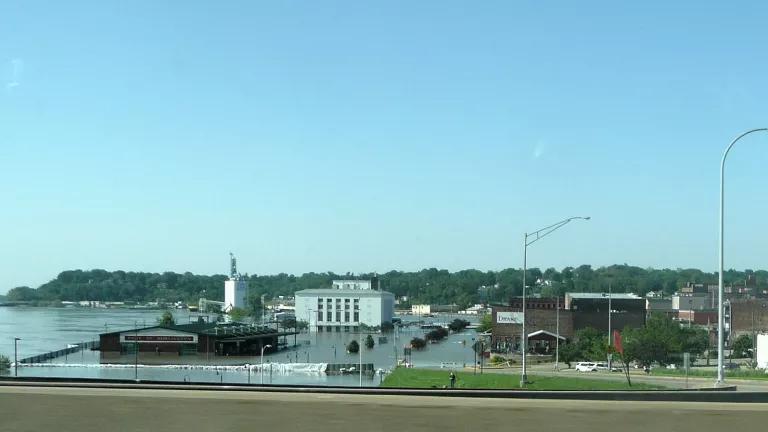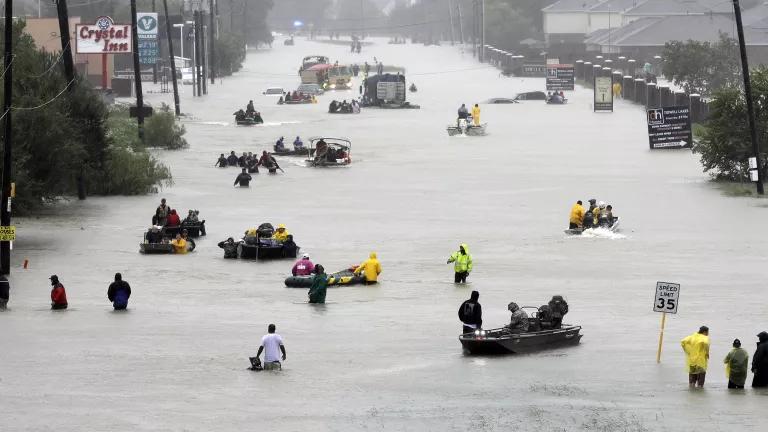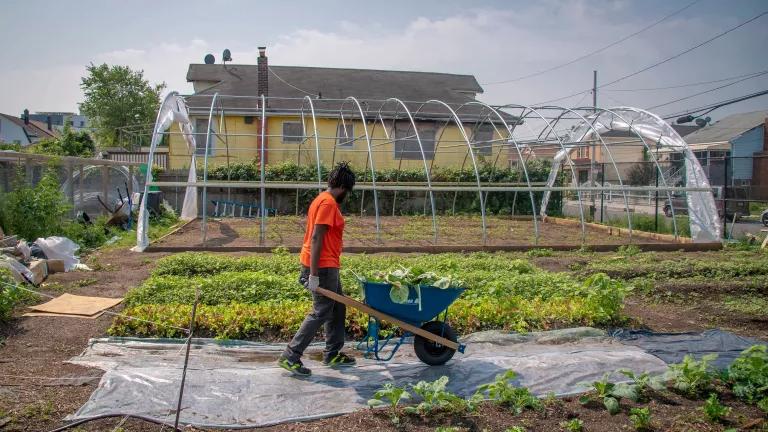Midwest Floods May Lead Illinois to New Solutions
The Midwest floods of 2019 have caused hardship and loss but, Illinois has not seen much in the way of damages. Part of the reason is because Illinois has strong floodplain management regulations, something Governor Pritzker is expected to keep in place, despite pressures to roll them back.

The waterfront area of Burlington, Iowa, flooded by the Mississippi River.
The Midwest floods of 2019 have caused hardship and loss for much of the year across Missouri, Iowa, Nebraska, and Kansas. However, Illinois has experienced relatively little damage, despite a comparable amount of rainfall and rivers being just as swollen.
“It’s a non-event,” according to the Illinois’s Floodplain Manager, Paul Osman, when talking about the 2019 floods.
Illinois has strong floodplain management regulations and a long history of helping communities reduce their vulnerability to flooding.
Not only has the state helped relocate more than 6,000 homes and other structures in the floodplain, Illinois also has some of the best floodplain regulations among Midwestern states. Governor Pritzker, who took office just this year, should be proud that:
- Almost every community in Illinois requires homes in the floodplain to be built at least one foot higher than the height of the 100-year flood, helping ensure that floodwaters don't cause damage.
- Development cannot take place in the floodplain if it would raise flood heights more than 0.1 foot in urban areas or 0.5 feet in rural areas, not only guiding development out of the floodplain, but also ensuring that flooding isn't made more likely elsewhere.
- Levees cannot be raised if doing so would make flooding worse in communities upstream, downstream, or across the river.
But as climate change tilts the odds in favor of longer, more frequent floods, Illinois and other Midwestern states will need to stay ahead of the growing risks. Illinois may have some of the best programs for managing flood risk in the present, but improvements are needed to accommodate floods that climate change may make bigger, longer lasting, or more frequent.
Since the 1800s, river communities in Midwestern states have often relied upon levees— earthen structures designed to keep floodwaters at bay. And when floodwaters have overtopped levees, the response has been to build bigger and higher levees. But that approach has some practical limitations.
Relying on levees means a commitment to maintaining them forever. Bigger levees equate to more maintenance costs. As levees get raised to hold back bigger floods, that means floodwaters can go higher, perhaps flooding nearby areas whose levees are lower or maybe don’t even have levees. This can be a real problem for poorer communities that cannot afford to engage in a never-ending game of “who-can-raise-their-levees-fastest.”
An alternative strategy is to set levees farther back, giving rivers access to more of their natural floodplain and allowing floodwaters to spread out, rather than rise as they press against levees. Levee setbacks have been done in California and Iowa. This is a practice that could greatly benefit Illinois—where levee setbacks have never been done—as well as other Midwestern states that need to prepare for more flooding as the climate changes.
Another strategy is to give a river access to its historical floodplain during major flood events. Emiquon, in Illinois, is a fantastic example of such a project. The Nature Conservancy purchased this property and installed a gate in the levee, occasionally allowing floodwaters to reclaim part of the Illinois River's natural floodplain—an area that had been completely cut off by the levee for decades.
But there are still those who prefer nineteenth-century solutions to twenty-first-century problems. Levee districts have been actively lobbying Illinois to severely diminish the state’s oversight of their construction activities. Weaker regulations would enable districts to raise their levees and avoid the state's analysis of whether doing so would make flooding worse elsewhere.
This isn’t just happening in Illinois. An investigative piece published in Pacific Standard showed how levee districts are trying to weaken regulations elsewhere, including federal regulations enforced by the U.S. Army Corps of Engineers. (See Levee Wars: how a secretive lobbying group is working to subvert flood regulations)
In 2017, Governor Pritzker’s predecessor, Governor Bruce Rauner, directed the Illinois Department of Natural Resources to severely weaken regulations that pertain to levee construction—regulations originally adopted after the Great Flood of 1993, when it became clear that more oversight was essential. Luckily, Governor Rauner's misguided proposal was never finalized.
Hopefully such proposals are in our rearview mirror and we can look forward to Governor Pritzker’s administration championing more thoughtful and progressive measures of flood protection. As climate change makes more extreme rainfall and flooding more likely, we need to adapt to those changing conditions and employ a much wider array of strategies to lower our risks.




